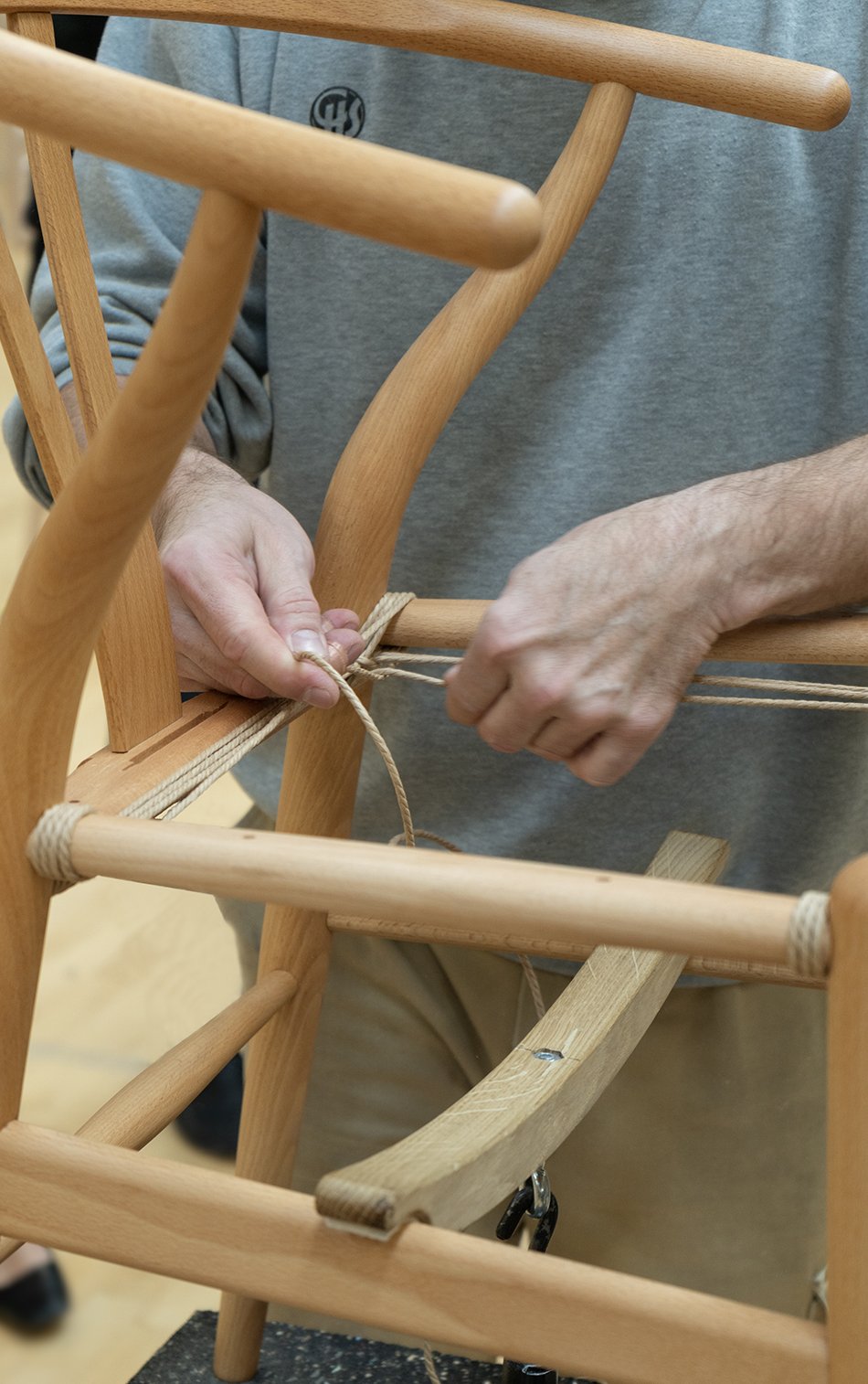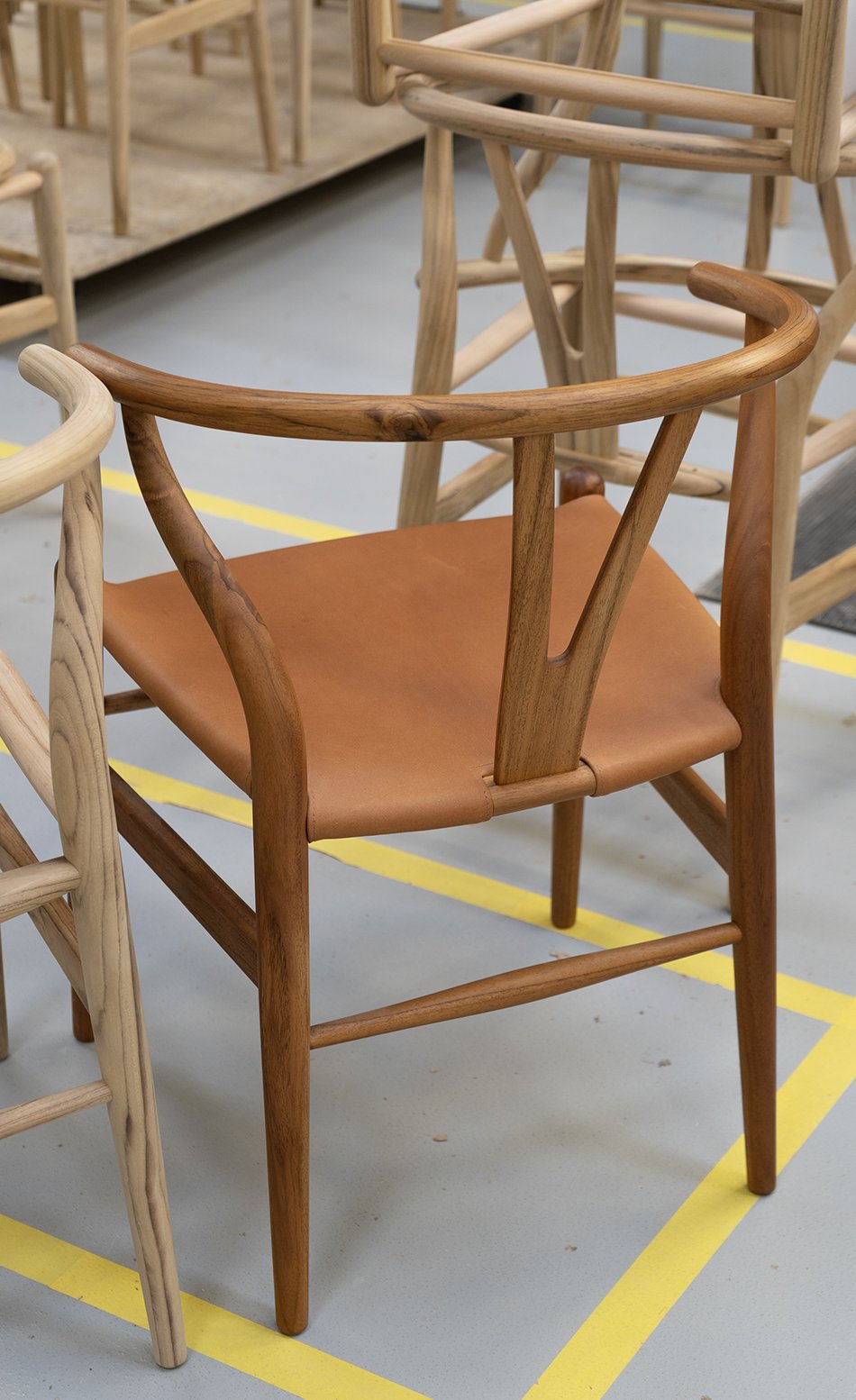The Making of The Wishbone Chair - Factory Tour
The CH24 Wishbone chair in oak awaits its paper cord seat on the factory floor at the Carl Hansen & Søn factory in Gelsted, Denmark.
[AD - this post is in partnership with Carl Hansen & Søn as part of their Wishbone chair 2022 press tour]
Fewer things get me more excited than a furniture factory tour. The offer to take a peek behind the curtain surrounded by the fragrant smell of warm cut wood and the white noise of industrial scale machinery is too good to pass up. Diamonds don't impress me, darling.
On an early morning in October, I found myself coach-bound for the island of Funen, a two hour drive from Copenhagen and headed to Carl Hansen & Søn's headquarters in Gelsted. This landmark tour for like-minded interiors bloggers would give us behind-the-scenes insight into the making of the iconic and original Wishbone chair. Often poorly imitated, never matched in quality.
Woodworking tools of the trade inside the Carl Hansen & Søn factory headquarters.
A make-shift chair that didn't make the grade is used on the factory floor.
Stack of oak Wishbone chairs await their backrest and arm rests on the factory floor in Denmark.
Over 100 Years of Considered Craftsmanship
In the years I've worked with Carl Hansen & Søn, I've learned a great deal about their approach to sourcing sustainable materials, important to the continuation of their high level of craftsmanship. Traditional wood-crafting and weaving techniques are still used today. There are no short-cuts or cost-saving cheap materials to ensure each design leaving the factory will last a lifetime.
Where it all begins - the workshop master for the Wishbone chair displays all the pieces that make up this modernist chair.
What started life in 1908 as a small furniture workshop by founder Carl Hansen evolved into a third generation family run business that begin nurturing the work of pioneering modernist designers in 1949. One such designer, Hans J. Wegner, was discovered by Hansen's son Holger who took an instant liking to his collection, including the now world-renowned Wishbone chair.
The rest, as they say, is history and 70 years later this modernist chair is still in production, making it their most popular design to this day. You'll spot it in restaurants, hotels and homes (including my own) just quietly minding its own as the most iconic Danish design chair in history.
The Making of The Wishbone Chair
The iconic Wishbone chair back rest lying in neat stacks ready for construction inside the Carl Hansen & Søn factory.
You'd be forgiven for assuming that most of their furniture is entirely machine manufactured, but there are experienced human hands on every touch-point of the making of this chair. From the initial cutting and carving, to sanding, gluing and weaving, every piece is finished with exacting standards.
And the reason to invest in original design is evident in the beauty of the details and true craftsmanship. Did you know there are over 100 steps that go into building one Wishbone chair? It felt like such an absolute privilege to be allowed to explore each step in the process, including being let loose on some of the machinery. I wasn't offered the job.
Beautifully sanded chair legs ready to become part of the frame of the iconic CH24 chair by Hans J. Wegner.
Wegner's Danish Modern chair consists of 14 components and a team of craftsmen assigned to focus on a particular stage. Each piece is still made by hand more or less in the same way it was intended when the chair was first launched. It features that iconic wishbone shaped back rest which slots into a single steam-bent curved arm running around the back.
Steam-bend arm rests made inside the factory in Denmark, neatly stacked and ready for the next stage.
Gluing the components of the CH24 chair, piece by piece, on a work bench inside the Carl Hansen & Søn factory.
Perhaps the most mesmerising part of the tour was arriving at the weaver's workshop where 125 m of natural paper cord is expertly woven into a strong, durable seat. Danish paper cord really came into its own in the 1940s and well into the modernist era as a durable alternative to straw or rattan.
And it's all in the tension, paying attention to those exacting right-angles, passing the cord over the sides of the frame and back under. The result gives you that 'X' shape in the centre.
Weaving the iconic Wishbone chair seat with 125m of natural paper cord.
If you manage to pass four weeks worth of training, it should take approx. 1 hour to weave the signature seat and you could see how easy it was to find a rhythm once you were in the zone. I tried to take in the exact method, watching our guide demonstrate how to achieve those perfect right angles...but who was I kidding?
Reels of natural paper cord made to weave iconic Danish design chairs wait on shelves inside the Carl Hansen & Søn factory.
A close-up of weaving the Wishbone paper cord seat onto the chair.
Two finished Wishbone modern chairs in oak and mahogany inside the Gelsted factory in Denmark.
The finished Wishbone chair in a beautiful natural oak frame waiting on the factory floor.
Sustainable Danish Furniture
It stands as a testament to CEO and Hansen's grandson Knud Erik Hansen and the team that the majority of furniture in their collection is still made by hand in Denmark. It carries all the hallmarks of a small family business despite its world famous reputation and I love it for that reason.
Other pieces are taken on by their factory in Vietnam, run by Knud Erik's son and fourth in the generation, Mark Nam Hansen. The location is entirely self-contained with its own sawmill and workshops. This hands-on approach maintains high quality control and a sustainable supply chain.
All wood used in production is FSC certified, sourced from responsibly managed forests. Waste products such as leather and wood off-cuts are re-purposed as part of their accessories collection and I was amazed to discover the Gelsted factory has its own power plant. Using waste by-product from wood shavings, it heats not only the factory but up to 400 houses in the local vicinity of Gelsted.
I'd say that's a heritage worth continuing, wouldn't you?
Photography © Tiffany Grant-Riley
















